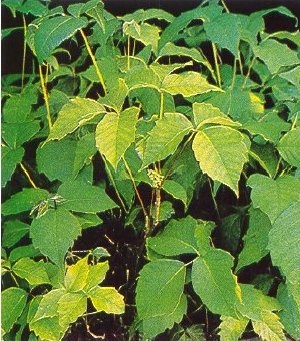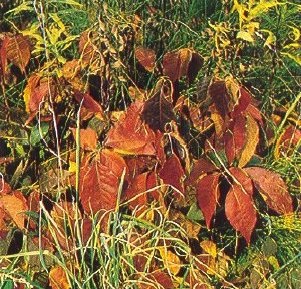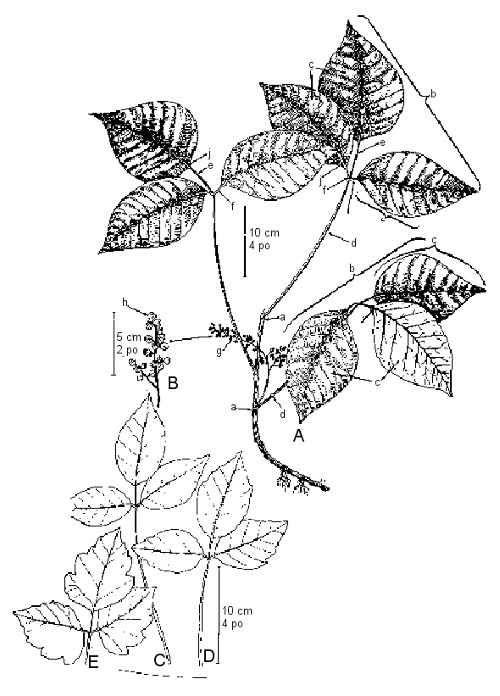Poison ivy
Learn how to identify, control and the harmful effects of poison ivy.
ISSN 1198-712X, Published June 1999
Distribution in Ontario
Poison-ivy (Rhus radicans L.) is widespread throughout southern Ontario and reaches north approximately as far as Cochrane and Kenora. It is found most abundantly, however, south of a line from the north shore of Lake Huron through North Bay. This includes the densely populated portions of the province and the popular vacation areas. The plant is often mistakenly called "poison oak", but the true poison oak occurs only in the southern and Pacific states of the U.S.A. and not in Ontario.
Poison-ivy is extremely variable in both its habit of growth and kinds of habitat. It grows in deep woods or in the open; in dry, sandy areas, crevices of rocks, or swamps; along the borders of woods, fencerows, or roadsides. You are not safe even in your own garden, and you may be surprised to find it growing in your flower beds or shrubbery. Usually it is found in low-growing, rather dense colonies, sometimes practically carpeting the ground. In the counties bordering Lake Erie, there is also a vine form which twines around and climbs up trees, shrubs and posts, often reaching several metres (yards) above the ground.
Description
Poison-ivy is a woody perennial. It may grow as dwarf, shrubby plants only a few centimetres high and carpeting the ground (Figure 1), or as upright plants 60–90 cm (2–3 ft) high, or the vine-like form may twine around trees, shrubs and posts, and reach a considerable distance above the ground. These vines often develop root-like structures which act as attachments, but apparently do not damage the living plants to which they cling.
"Leaflets three — Let it be!" Each leaf of poison-ivy consists of three leaflets so the leaf is said to be "compound". (See bracket marked "b" in Figure 3A for one complete compound leaf and bracket and arrows marked "c" for individual leaflets.) The stalk (e) of the middle leaflet is longer than the stalks (f) of the 2 side leaflets. All 3 leaflet stalks (e and f) are joined together at the tip of one much longer stalk (d) which is called the petiole. The other end of the petiole is attached to the woody stem at a node or "joint" (a). There is only one petiole at each node and, when there are several leaves they usually alternate from one side of the stem to the other at successive nodes.
In spring and early summer the young unfolding leaflets are reddish or bronzy green (Figure 1, left side, below center) and droop or hang limply from the ends of their upraised petioles.
They gradually become firmer and stand out nearly level with the end of the petiole. Their color also changes to deep to bright green. Their upper surface is nearly smooth and sometimes has a glossy or "varnished" appearance. In bright, sunny areas the leaves turn a vivid orange-red to wine-red during autumn (Figure 2), but in shaded places they often lack the bright colors, just turning dull tan or light brown before dropping off.
Although the leaflets are somewhat oval, they vary greatly in shape and size. Their margins vary from perfectly smooth (Figure 3A) to finely or coarsely toothed (Figure 3D), to deeply and irregularly lobed (Figure 3E). Undersides of the leaflets may be finely hairy all over, or just along the veins and veinlets, or may be virtually without hairs.
Shortly after the leaves have formed in the spring, clusters of small, erect, greenish-white flowers develop on some plants in the angles where the leaf petioles join the stem (g). They are often hidden by the leaves (Figure 1, center). During the summer these flowers develop small round hard berries about 5 mm (1/5 in.) in diameter (h).
After the leaves have dropped in the fall, poison-ivy can be identified easily by the clusters of grayish to white, waxy-looking berries (Figure 3B) on short, erect, bare stems which have alternately arranged buds and leaf-scars. The berries are distinctly longitudinally lined, and upon close examination may remind one of a miniature peeled orange. Some fruits vary from the typical, and may be quite hairy.
Poison-ivy is spread by seed, but it also has extensive underground stems from which new plants develop. For this reason, killing the aboveground parts does not mean that the plant has been destroyed, and new shoots may appear at any time from these underground structures.
Similar but harmless plants
Many plants have been mistaken for poison-ivy because their leaves may also consist of 3 leaflets. These can be distinguished from poison-ivy as follows.
- Clematis is a climbing or trailing vine but has opposite leaves (2 compound leaves come from each node on the stem) and larger white or blue flowers.
- Hog-peanut and ground nut are vines with alternate leaves (like poison-ivy) but with clusters of small whitish to purplish or brownish flowers like those of the sweet pea.
- Raspberry, blackberry and dewberry usually have spiny or prickly stems and white to pink or red flowers with many stamens.
- Manitoba maple seedlings and basal sprouts have opposite leaves and on other parts of the plant most leaves have 5 leaflets.
- Virginia creeper often has 5 or 7 leaflets in other leaves on the same plant and its berries are bluish.
Nevertheless, when in doubt, avoid touching the unknown plant until you have obtained help to identify it.
Control of poison ivy
Poison-ivy can be controlled by grubbing (digging) out the roots and stems as well as by the use of certain herbicides (chemical weed-killers). Herbicides offer some advantages over mechanical methods. The danger of a person receiving poison-ivy dermatitis either by direct contact with the plant or indirectly by touching contaminated tools, etc., is much less with herbicidal methods than with mechanical methods. Control of the weed is usually simpler and more effective by the careful and correct use of herbicides than by mechanical methods (It is almost impossible to remove every piece of underground stem so regrowth is likely to occur.)
However, all of the herbicides which kill poison-ivy may also kill or damage other plants growing nearby. If poison-ivy is growing among perennial ornamentals, in a hedge, or entwined about a favorite tree, one must resort to cutting and digging to destroy it. Wear gloves and other protection while cutting and grubbing. Take care also to prevent other persons from being inadvertently contaminated by the tools, the roots, stems and leaves, or by the smoke if the material is burned (see section on Harmful Effects).
Several herbicides (chemical weed-killers) have been used effectively for providing good control of poison-ivy:
- amitrole
- glyphosate
- mixtures containing 2,4-D with mecoprop and/or dicamba
- mixtures of amitrole with simazine
These herbicides can be bought in various concentrations and under many different trade or brand names. Therefore, it is not feasible in this Factsheet to give detailed instructions for mixing and application of each kind. Detailed directions for its use are printed on the label on every container of each herbicide. Follow the manufacturer's directions. For safety's sake, read the label carefully and observe all precautions printed on it.
These herbicides are usually most effective if applied anytime from when the foliage is fully developed until the plants begin to go dormant, usually from about June 15 to July 31. Some regrowth of the weed may occur after it has been treated. Therefore, examine the area periodically and the repeat treatment as often as any regrowth appears. In this manner, poison-ivy can often be eliminated from an area.
A 2- or 3-gallon sprayer is the most convenient method of applying herbicides to patches of poison-ivy. Thorough coverage of every plant in the area is essential for maximum effect. All leaves and stems must be thoroughly wet to the ground line.
For additional information on these and other herbicides, and on the selection, care and use of herbicide application equipment see Ontario Ministry of Agriculture and Food Publication 75, Guide to Weed Control.
Harmful effects
Poison-ivy has a distressing toxic action on the skin of people who become sensitized to it. The offending substance of the plant is an oil which is present throughout root, stem, leaf, flower, and fruit. Tearing or bruising of any part liberates the oil that may come in contact with the exposed parts of the body, either directly or by handling contaminated objects.
This oil may stick to clothing, especially boots, tools, or picnic baskets, and may be easily transferred to the hands and the face and by touching, rubbing or handclasp, to other persons who have not been directly exposed at all.
Pets can also become contaminated by running through patches of poison-ivy. Although animals do not react to the poison, a sensitive person can be poisoned merely by petting a contaminated animal. The oil is also said to be vaporized by heat such as would be present in a bonfire or a smudge. The vapour thus formed may be carried by the smoke and if a susceptible person walks through the smoke or inhales it, very serious reactions may result. The oil may also be vaporized, or sprayed out like an atomizer, from fresh plants as they are being cut and contaminate a nearby person or the person's clothing even though there is no direct contact with the poison-ivy plant.
Individuals vary greatly in susceptibility to ivy poisoning and many have never suffered any ill effects. However, those in the latter category should not take for granted that they are immune for all time.
Cross reactivity
Because several other kinds of plants are related to poison-ivy and poison sumac, those related plants or some of their products may cause a similar dermatitis reaction in sensitive people. If a person has been sensitized to poison-ivy, that person may, in future, react to such things as the rind of the mango fruit, Japanese lacquer, India marker ink, the oil from the cashew nut shell such as found on some elaborate swizzle sticks, and the fruit pulp of the Ginkgo tree.
Recognition and cooperation are essential
Poison-ivy is classified as a noxious weed under the Ontario Weed Control Act. This legislation provides a means for regulating control of certain weeds in problem areas. Each municipal council, through its weed inspector, is responsible for the degree of control within its district.
Every person should accept the responsibility of learning to recognize poison-ivy. Municipal councils, road authorities, summer resort owners, persons in charge of parks and conservation areas, and the general public are urged to control this weed wherever feasible. Cooperation and united effort are essential. But the ultimate responsibility falls to each person: learn to recognize it; teach others to recognize it; and avoid contact with it.


